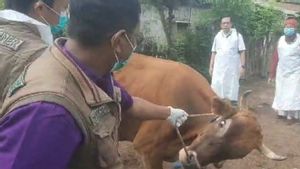JAKARTA - December marks exactly 12 months since the first patient in Wuhan, China showed symptoms of a disease with no known cause. The death toll is starting to fall and the number of people infected with the virus, which is now known worldwide as COVID-19 and is impacting lives around the world today.
On February 10, 2020, Chinese President Xi Jinping, who has been absent for weeks from public view, spoke to hospital staff in the city of Wuhan who are struggling to contain the spread of the new coronavirus, which has not been officially named. Xi Jinping urged greater public communication, as concerns around the world mount about the potential threat posed by the new disease.
On the same day, Chinese authorities reported 2,478 new confirmed cases, raising the global total number to more than 40,000, with fewer than four hundred cases outside mainland China. However, there is an official document circulating internally showing that the data is not real data.
Citing CNN, Wednesday, December 2, in a report marked "internal document, please keep confidential", health authorities in Hubei Province, where the virus was first detected, listed a total of 5,918 new cases detected as of February 10, more than double the the amount conveyed to the public. This larger figure was never fully revealed at the time, due to China's counting system and underestimating the severity of the outbreak.
The figure that was previously kept secret is one of many reported in the 117-page leaked document from the Hubei Province Centers for Disease Control and Prevention. Overall, the document represents the most significant leak from China since the start of the pandemic and provides a clear picture of what local authorities know internally.
The Chinese government has frequently rejected accusations made by the United States (US) and other Western governments that China has deliberately withheld information related to COVID-19. However, the document does not provide evidence of an attempt to obfuscate the findings, it does reveal many inconsistencies in what the authorities believed and what was disclosed to the public.
The document also reveals an inflexible health care system constrained by bureaucracy and inadequate rigid procedures to deal with crises. At some critical moments in the early phases of the pandemic, documents show clear evidence of missteps and point to patterns of institutional failure.
One of the more striking data points concerns the delay in local COVID-19 diagnosis. Although authorities in Hubei presented initial outbreak management to the public in an efficient and transparent manner, documents show that local health officials rely on flawed testing and reporting mechanisms. A report in a document from early March said the average time between the onset of symptoms and a confirmed diagnosis was 23.3 days, which experts say significantly hinders measures to monitor and combat the disease.
China has steadfastly defended its handling of the outbreak. At a press conference on June 7, China's State Council released a White Paper saying that the Chinese government always publishes epidemic-related information in a timely, open and transparent manner.
"While doing its best to contain the virus, China is also acting with a high sense of responsibility towards humanity, its people, its descendants and the international community. China has provided information about Covid-19 in a professional and efficient manner in a thorough manner. China has released authoritative and comprehensive information. early details on a regular basis, so as to effectively respond to public attention and build public consensus, "quoted from the White Paper.
The influenza "epidemic", as officials noted in the document, did not only occur in Wuhan in December 2019. The disease has already hit neighboring cities such as Yichang and Xianning. It remains unclear what impact or link the influenza surge will have on the COVID-19 outbreak. Although there is no record in the document that the two parallel crises are linked, information about the magnitude of the influenza surge in Hubei is not published.
So far, international experts' access to hospital medical records and raw data in Hubei Province has been restricted. The WHO said last week that it had "assurances from Chinese government colleagues that trips to the field" would be provided as part of their investigation.
In addition, the document also shows inaccurate testing from the start that caused the reporting system to delay for weeks in diagnosing new cases. This implies that most of the daily figures to which the government responds risk being inaccurate.
The high rate of false negatives uncovers a series of problems that took China weeks to fix. According to reports in Chinese state media in early February, Hubei health experts were frustrated by the inaccuracy of the nucleic acid tests. The nucleic acid test works by detecting the genetic code of the virus and is considered to be more effective in detecting infection, especially in its early stages.
China's lack of preparedness for COVID-19 is reflected throughout the document, parts of which are critical in the internal assessment of government support for the operation of the Centers for Disease Control and Prevention in Hubei.
The English, Chinese, Japanese, Arabic, and French versions are automatically generated by the AI. So there may still be inaccuracies in translating, please always see Indonesian as our main language. (system supported by DigitalSiber.id)













